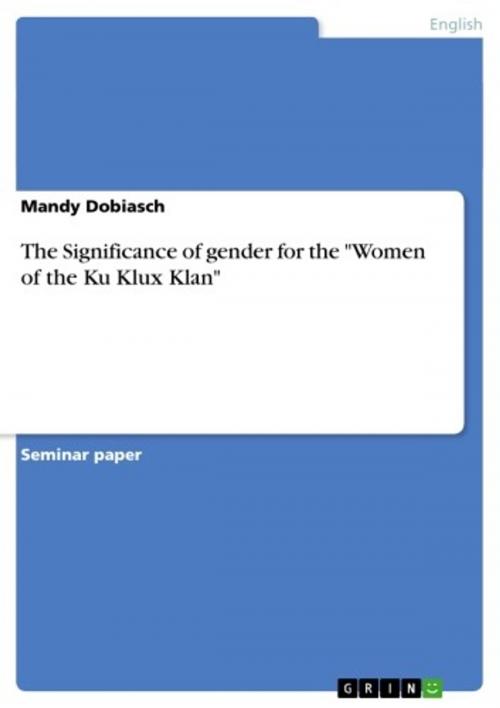The Significance of gender for the 'Women of the Ku Klux Klan'
Nonfiction, Entertainment, Drama, Anthologies| Author: | Mandy Dobiasch | ISBN: | 9783638300070 |
| Publisher: | GRIN Publishing | Publication: | August 13, 2004 |
| Imprint: | GRIN Publishing | Language: | English |
| Author: | Mandy Dobiasch |
| ISBN: | 9783638300070 |
| Publisher: | GRIN Publishing |
| Publication: | August 13, 2004 |
| Imprint: | GRIN Publishing |
| Language: | English |
Seminar paper from the year 2004 in the subject American Studies - Culture and Applied Geography, grade: 1,2 (A+), University of Potsdam (Anglistics/ American Studies), course: America in War and Peace: Jazz Age to World War II, 16 entries in the bibliography, language: English, abstract: After the Civil War, many Southerners were dissatisfied with their situation. The lost war and the fact that many existences were destroyed due to the collapse of the Southern economy, stirred the anger among many of them. The abolition of slavery that was forced upon them and which until then was the basis of their economic prosperity, was the more serious. This discontent then changed to hate towards the former slaves. Many former slave holders came together and formed what became known as the first Ku Klux Klan, an organization that tried to overthrow the system and to return to the old one by lynching and intimidating black citizens. This dark chapter of American history should not remain the only one. After the disappearance of the first Ku Klux Klan, partly because of the passing of the 'Ku Klux Klan Acts' of 18701, racial frictions played a minor role, although they never completely disappeared. In the following decades the American people were especially at the end of the century concerned with the ongoing industrialization and development of the country. World War I even saw the involvement of African Americans in the service. It was not until the end of the war and the end of all war enthusiasm that Americans were confronted with the legacy of the Civil War outcomes. The racial turmoil of the post-war era led to the re-emergence of the Ku Klux Klan, generally referred to as the second Klan. Although similar in its basic principles, the two organizations had different ideas altogether. One major difference was the foundation of a female branch of the Ku Klux Klan - the 'Women of the Ku Klux Klan'.
Seminar paper from the year 2004 in the subject American Studies - Culture and Applied Geography, grade: 1,2 (A+), University of Potsdam (Anglistics/ American Studies), course: America in War and Peace: Jazz Age to World War II, 16 entries in the bibliography, language: English, abstract: After the Civil War, many Southerners were dissatisfied with their situation. The lost war and the fact that many existences were destroyed due to the collapse of the Southern economy, stirred the anger among many of them. The abolition of slavery that was forced upon them and which until then was the basis of their economic prosperity, was the more serious. This discontent then changed to hate towards the former slaves. Many former slave holders came together and formed what became known as the first Ku Klux Klan, an organization that tried to overthrow the system and to return to the old one by lynching and intimidating black citizens. This dark chapter of American history should not remain the only one. After the disappearance of the first Ku Klux Klan, partly because of the passing of the 'Ku Klux Klan Acts' of 18701, racial frictions played a minor role, although they never completely disappeared. In the following decades the American people were especially at the end of the century concerned with the ongoing industrialization and development of the country. World War I even saw the involvement of African Americans in the service. It was not until the end of the war and the end of all war enthusiasm that Americans were confronted with the legacy of the Civil War outcomes. The racial turmoil of the post-war era led to the re-emergence of the Ku Klux Klan, generally referred to as the second Klan. Although similar in its basic principles, the two organizations had different ideas altogether. One major difference was the foundation of a female branch of the Ku Klux Klan - the 'Women of the Ku Klux Klan'.















